
Vegavis is a genus of extinct bird that lived in Antarctica during the Maastrichtian stage of the Late Cretaceous. The type species is Vegavis iaai. Vegavis was initially considered to be a member of Anseriformes within Galloanserae, but this claim has not been supported by some recent studies.

Paraptenodytes is an extinct genus of penguins which contains two or three species sized between a Magellanic penguin and an emperor penguin. They are known from fossil bones ranging from a partial skeleton and some additional material in the case of P. antarcticus, the type specimen for the genus, and a single humerus in the case of P. brodkorbi. The latter species is therefore often considered invalid; a recent study considers it indeed valid, but distinct enough not to belong into Paraptenodytes. The fossils were found in the Santa Cruz and Chubut Provinces of Patagonia, Argentina, in the Gaiman, Monte León and Santa Cruz Formations of Early to Middle Miocene age. Later occurrences are apparently from Late Miocene or possibly even Early Pliocene deposits.
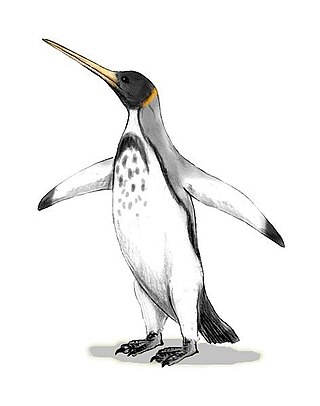
Icadyptes is an extinct genus of giant penguins from the Late Eocene tropics of South America.

Lithornithidae is an extinct, possibly paraphyletic group of early paleognath birds. They are known from fossils dating to the Upper Paleocene through the Middle Eocene of North America and Europe, with possible Late Cretaceous representatives. All are extinct today; the youngest specimen is the currently unnamed SGPIMH MEV1 specimen from the mid-Eocene Messel Pit site.
The Mustersan age is a period of geologic time within the Eocene epoch of the Paleogene, used more specifically within the South American land mammal age (SALMA) classification. It follows the Casamayoran and precedes the Divisaderan age.
The Divisaderan age is a South American land mammal age, covering a period of geologic time within the Middle and Late Eocene epochs of the Paleogene. It follows the Mustersan age and is followed by the Tinguirirican age.
Amitabha urbsinterdictensis is an ancient bird from the Middle Eocene in North America. One specimen has been found to date. Bonnie Gulas-Wroblewski and Anton Wroblewski described and named it in 2002.

Inkayacu is a genus of extinct penguins. It lived in what is now Peru during the Late Eocene, around 36 million years ago. A nearly complete skeleton was discovered in 2008 and includes fossilized feathers, the first known in penguins. A study of the melanosomes, pigment-containing organelles within the feathers, indicated that they were gray or reddish brown. This differs from modern penguins, which get their dark black-brown feathers from unique melanosomes that are large and ellipsoidal.
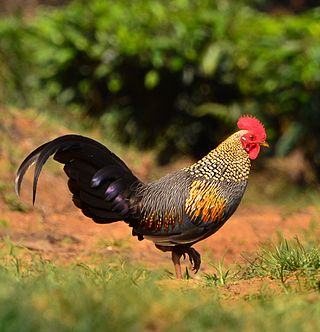
Pangalliformes is the scientific name of a provisional clade of birds within the group Galloanserae. It is defined as all birds more closely related to chickens than to ducks, and includes all modern chickens, turkeys, pheasants, and megapodes, as well as extinct species that do not fall within the crown group Galliformes.
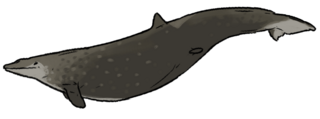
Supayacetus is an extinct genus of basilosaurid cetacean from the Middle Eocene Paracas Formation of Peru. It has been noted for its relatively small size and basal morphology, with the sternum bearing close resemblance to those of protocetids. Due to this, it has been traditionally placed as one of the basalmost basilosaurids, except for a 2023 study that places it within the family Pachycetinae close to Neoceti. Supayacetus is monotypic, meaning the genus includes only a single species: S. muizoni.

Kairuku is an extinct genus of penguin. It contains three species, K. grebneffi, K. waitaki and K. waewaeroa. This taxon is known from bones from 27 MYA, from the Kokoamu Greensand Formation of New Zealand. It was historically referred to as Palaeeudyptes.
Avolatavis is an extinct genus of stem-parrot (pan-psittaciform) or a member of the stem group of Psittacopasseres, known from the early Eocene Fossil Butte Member of the Green River Formation of Wyoming, United States, and from the London Clay of Walton-on-the-Naze. It was first named by Daniel T. Ksepka and Julia A. Clarke in 2012 and the type species is Avolatavis tenens. Gerald Mayr and Andrew C. Kitchener described the second species, A. europaeus, in 2023. Mayr and Kitchener assigned Avolatavis to the family Vastanavidae, which might be early diverging stem group presentatives of Pan-Psittaciformes or stem group representatives of Psittacopasseres.
Vastanavidae is an extinct family of birds related to parrots and passerine birds. They are known from fossils from Eocene sites in India, Europe, and North America. The vastanavids resemble parrots and the extinct parrot relative Quercypsitta in their morphology, including the partially zygodactyl foot, in which two toes could face opposite the other two.
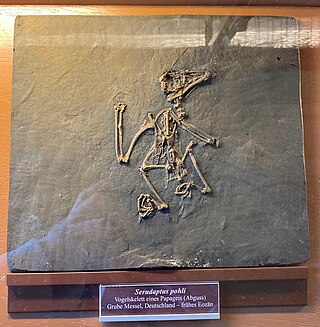
Halcyornithidae is an extinct family of telluravian birds thought to be related to the Psittaciformes (parrots), Passeriformes (songbirds), and to the extinct Messelasturidae. Halcyornithids have been found in various Eocene formations in Europe and North America. Widespread and diverse in the Early Eocene of North America and Europe, halcyornithids are not found in locales later than the Middle Eocene. Halcyornithids were small, arboreal birds with zygodactyl feet, with two toes facing forwards and two facing back, a trait shared with other tree-dwelling families of Eocene birds like the Zygodactylidae and the messelasturids. The skull of halcyornithids features a ridge of bone above the eye called the supraorbital process, similar to birds of prey. The relationships of the halcyornithids to other birds remain uncertain. Halcyornithids have been proposed as relatives to owls and as a lineage closer to parrots than to songbirds. Most recently, halcyornithids have been identified as the sister group of the clade including parrots and songbirds. It is also possible that Halcyornithidae is paraphyletic with respect to the Messelasturidae.

Julia Allison Clarke is an American paleontologist and evolutionary biologist who studies the evolution of birds and the dinosaurs most closely related to living birds. She is the John A. Wilson Professor in Vertebrate Paleontology in the Jackson School of Geosciences and a Howard Hughes Medical Institute Professor at the University of Texas at Austin.
Pisco Basin is a sedimentary basin extending over 300 kilometres (190 mi) in southwestern Peru. The basin has a 2 kilometres (6,600 ft) thick sedimentary fill, which is about half the thickness of more northern foreland basins in Peru.
Eocypselus rowei is an extinct bird believed to be ancestral to modern hummingbirds and swifts. It was a small bird, less than 5 in (13 cm) in length, and probably had black feathers. The bird was first described in 2013 and lived approximately 50 million years ago, during the Eocene epoch.

Tonsala is an extinct genus of Plotopteridae, a family of flightless seabird similar in biology with penguins, but more closely related to modern cormorants. The genus is known from terrains dated from the Late Oligocene of the State of Washington and Japan.
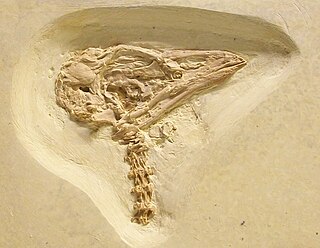
Cyrilavis is an extinct genus of halcyornithid bird from the Early Eocene Fossil Butte Member of the Green River Formation, United States. The genus contains two species, Cyrilavis olsoni and Cyrilavis colburnorum.
Pakudyptes is a genus of extinct penguins from the late Oligocene Otekaike Limestone of New Zealand. The genus contains a single species, P. hakataramea, known from three fragmentary limb bones.













